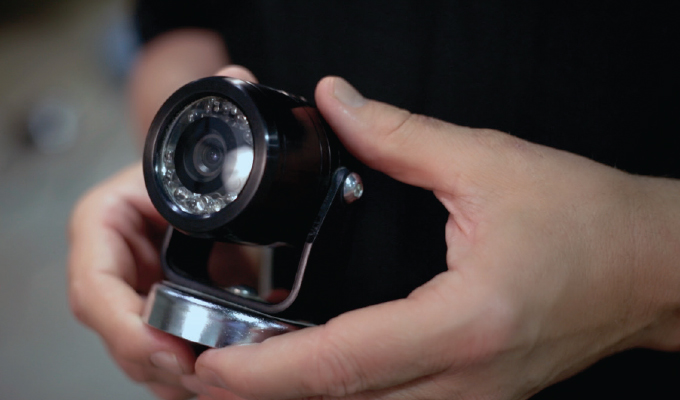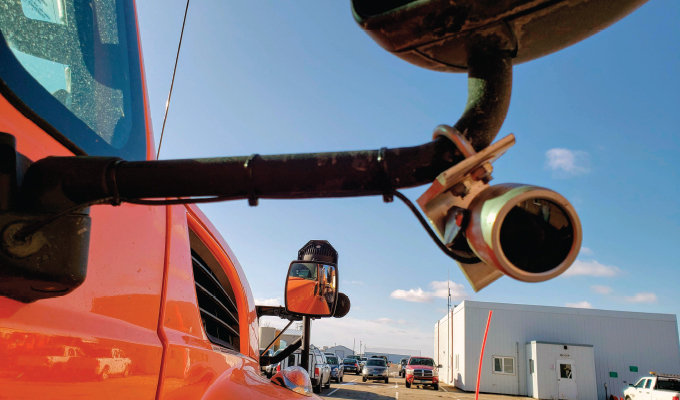According to the Bureau of Labor Statistics, workplace injuries in the construction industry continue to remain steadily high with transportation incidents accounting for the largest share of fatalities. Why the trend? Well, the National Institute for Occupational Safety and Health found one of the biggest factors is poor visibility around vehicles. Work vehicles are getting bigger and bigger. While that’s great for efficiency, it’s not so great for blind spots. The larger the blind spot areas, the more opportunity for accidents. But this is 2021—don’t most work trucks come with cameras to aid visibility? Some, but it’s not standard. There is a fix, though, and it’s in aftermarket camera systems.
FIELD TESTED
Dave Turin, star of hit Discovery TV series “Gold Rush: Dave Turin’s Lost Mine,” partnered with Dakota Micro to install rear-view EnduraCam cameras on his service truck.
While some trucks come equipped with rear-view camera systems, Dave’s truck—as with many other work trucks—did not. The problem was his rear-view mirror view was completely obstructed, and his side mirrors couldn’t see directly behind him, leaving him prone to collision. That’s a problem.
Turin sums the main benefit of safety with the Dakota Micro camera system by saying, “So we work around a lot of camera folks, and they’ve never been around big equipment, and they get used to a back-up horn. They don’t even hear them anymore. So, for me to have this camera really is about safety. Because right here [behind service truck], with my mirrors, I probably couldn’t see somebody.”
TOP 2 BENEFITS
The two primary benefits of installing a rear-view camera system are to:
- Improve Safety—reduce number of accidents on the jobsite from blind spots.
- Enhance Efficiency—no more need for a spotter or getting in and out of your vehicle to see progress; see activity in real time.
Workers wear so many hats these days, and businesses are commonly short-staffed. It’s no secret that operators can use all the help they can get. Dakota Micro cameras can help fill the void. They cut down on radio chatter because operators can see obstacles for themselves in real time.
Nate Clark, mechanic for Dave Turin, also installed Dakota Micro cameras on his service truck. “It’s nice,” Clark says. “You know, especially with these big trucks with a big bumper on them, you can’t really tell exactly how close you are. Now with this, you back right up to it. It’s a helpful tool.”

BUILT DIFFERENTLY
Not all camera systems are the same. Some camera systems aren’t as tough as advertised and tend to be inadequate in heavy-duty applications. But Dakota Micro cameras are built differently in four ways.
1. LENSES
Dakota Micro builds its camera lenses to operate in the harshest environments. They feature:
- Triple-hardened glass to resist scratching, scuffing, and static buildup (which attracts dust), offering a better view in harsher environments.
- Auto-focusing to focus past debris for an unobstructed view.
- Auto-darkening with infrared lights that turn on automatically in low-light conditions to work longer into the night or earlier in the morning hours.
- Photogray lenses that act like transitions lenses on eyeglasses; these photogray lenses darken in bright light conditions so you don’t just see a white-out on your screen.
2. CAMERA BODY
Dakota Micro EnduraCam cameras are carved from a solid billet of anodized aluminum. This increases the cameras’ durability. Cast or molded metals are prone to breakage, especially in cold conditions. Additionally, plastic camera bodies are weakened in heat, cold, and sunlight. Further, steel cameras—while hardy—are expensive and rust when scratched. In contrast, Dakota Micro uses anodized aluminum, so it won’t rust when scratched or corrode when exposed to harsh elements or to caustic environments.
3. CABLES
Dakota Micro cameras also feature optional silicone-blend cables. This silicone blend allows cables to remain flexible in heat and cold conditions. Many manufacturers use PVC- jacketed cables, but they become rigid in the cold and degrade in the heat. This can cause small breaks in the jacket, which allow water and particulates to penetrate and compromise the cables.
The company also offers wireless solutions and offers adapter cables to retrofit existing third-party monitors, saving space and money.
4. DURABILITY
Cameras on work trucks should be durable enough to take a beating. That’s why the IP (ingress protection) and IK (impact protection) ratings matter. The Dakota Micro EnduraCam cameras have the highest IP69 and IK10 ratings. IP69 cameras are the best suited for outdoor applications because they are rated as completely dustproof and waterproof (plus they can be submerged indefinitely) and hold up to high-pressure power washes without breaking. IK10 (highest rating) withstands the highest impacts without risks of breaking from heavy-duty use.
5. REPAIRABLE, NOT CONSUMABLE
If your camera does break, it’s nice to work with a camera company that offers repairs. Often cameras are considered “consumable,” meaning, if you break it, you buy a new camera. But Dakota Micro offers repairable components that could save considerable amounts of money over the lifetime of your product.
ANSWER THE CALL
Not all camera systems are equal. Dakota Micro engineers one of the hardiest backup cameras on the market. Most importantly, these cameras answer the call of visibility needed in blind spots around large work trucks and even serve to increase efficiency on the jobsite. Working on a heavy-duty jobsite requires a heavy-duty camera.
ABOUT THE AUTHOR
Charissa Rubey is the owner and CEO of Dakota Micro, Inc., a “Made in America” camera manufacturer specializing in highly rugged commercial camera systems in North Dakota. Find out more, visit www.dakotamicro.com.




